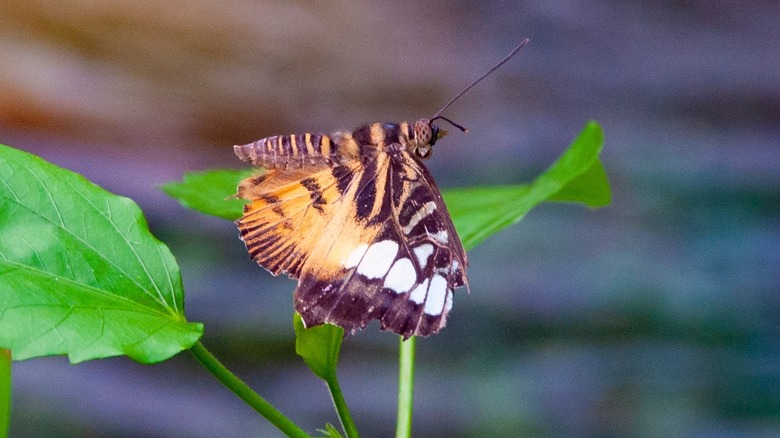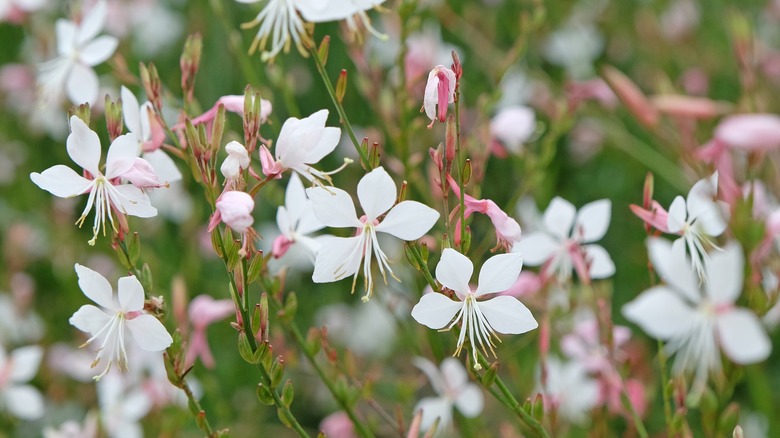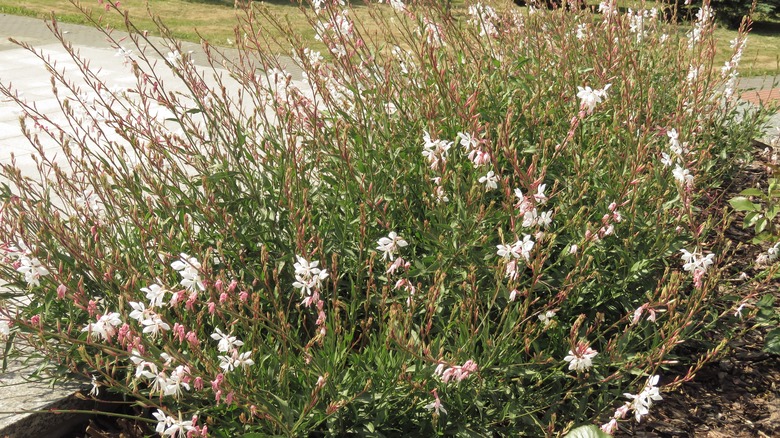This Flower Is A Butterfly Magnet & Makes A Perfect Perennial Border
It's thrilling to spy a butterfly resting on a garden flower. The beauty of these insects has made them synonymous with love, rebirth, hope, and transformation in art and literature, and it's easy to see why once you catch a glimpse of their delicate, ephemeral elegance. Symbolism aside, these pretty insects have an important role to play in a home garden — that is, pollination. Butterflies (and other pollinators) are a crucial part of the process of sustaining native wildlife, and their helpfulness might prompt home gardeners to search for plants that will fill their gardens with a variety of butterflies when planning ornamental plantings.
One such plant that attracts butterflies to your garden is Oenothera lindheimeri, previously known as Gaura lindheimeri and still colloquially known as gaura. Gaura produces white or pink flowers and are native to North America. They make a stunning addition to home gardens, both as a draw for butterflies and as a visually interesting, drought-tolerant plant that flowers for a long period each summer to fall.
Why gaura flowers are good pollinators
Gaura is often recommended as a plant well-suited for pollinator meadows or butterfly gardens, attracting bees, butterflies, moths, and other pollinator insects. According to the National Wildlife Foundation, there are several characteristics that make for a good butterfly garden specifically: plants should have clustered, flat-topped flowers and be able to withstand full sun, given butterflies' propensity to feed in sunlight. They also recommend planting for continuous blooms throughout the summer — since butterflies need constant sources of nectar once they reach adulthood — and planting native flowers, as native pollinators often coevolve with local flora.
Gaura fits these specifications in several ways. First, they have a long blooming window (which can be further encouraged by deadheading), flowering from June through first frost. This allows butterflies to feed on gaura for a fairly long window of time. Additionally, their flowers grow in clustered spikes with four flat petals per bloom.
One need only look to gaura's common nicknames – Bee Blossom, Butterfly Gaura, Whirling Butterflies, etc. — to get a hint at its ability to attract pollinators to North American gardens. Try variations of gaura that bloom in pink and red, such as Siskiyou Pink or Gaudi Red, to further encourage butterflies; pink and red are among the colors known to draw butterflies' attention.
Gaura plants are perfect to use for borders
Gaura grow wispy, whimsical flower spikes that can reach five feet tall, with long, flowery stems that rise above the shrubby foliage of the plant. The tall stems of gaura can be planted along walkways and garden borders, as the dense clusters of leaves at the base of these plants will still make for defined edges or borders for your garden.
Gaura can be planted alongside other perennials or annuals, such as petunias, roses, or coneflowers, for multiple levels of blooms. If you prefer shorter border plantings that still attract butterflies and bloom prolifically, there are several smaller cultivars of gaura that reach only a couple of feet in height, including Star Pink, Corrie's Gold, and Passionate Pink.
Gaura's main draw as a border plant is its abundant, long-lived blooms. You can encourage the most blooms from your gaura by using fertilizer, deadheading spent blooms, and positioning your gaura in full sun. In warmer areas, gaura can remain evergreen, but most gardeners will see the foliage die back and reemerge perennially or biennially in colder winter conditions. It should be noted that some sources suggest that gaura, while perennial, may be short-lived as individual plants over the years, though they can also self-sow, increasing garden longevity by creating new plants. But with proper growth and care of gaura plants and a bit of good luck, you can expect their flowers — and the butterflies that love them — to beautify your gardens year after year.


